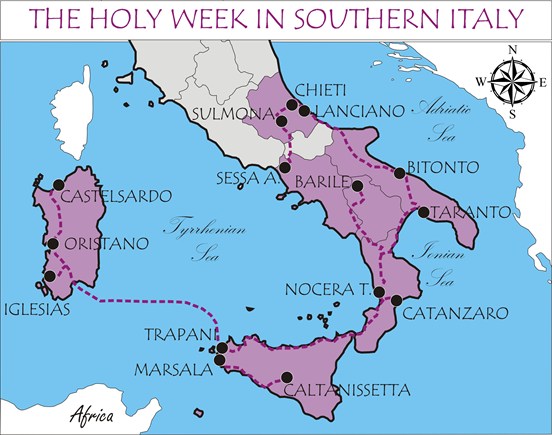The Holy Week in Southern Italy
 The last days of Christ’s life are marked by a precise chronology in the Gospels, made up of certain fundamental episodes. Not infrequently, however, as demonstrated by the rites of Holy Week in Southern Italy, these events are ordered anachronistic with respect to the temporal succession of the Easter Triduum. In particular, on Holy Thursday, on which only the Supper and Jesus’s capture and condemnation should be celebrated, often the denouement of the Crucifixion and Death of Christ (which should take place the next day) is commemorated. The most important example is the procession of the Vare of Caltanissetta and the re-enactment of the Misteri of Marsala. On the evening of Good Friday, however, in addition to representations with real people or statuary groups, there is also the procession of the Cristo Morto, the Dead Christ (the Naca of Catanzaro) and Our Lady of Sorrows, as well as the Way of the Cross (or re-enactment of the fourteen stations of Christ on the slope of Calvary). Among the extra-liturgical rites of Good Friday (vigils, fasts, pilgrimages) there are the processions of the Battuti or Vattienti, who self-inflict (as did the medieval congregations called the disciplinati) the penance of flagellation by wounding themselves, to amplify and expiate guilt by personal imitation of the Passion of Christ. In other places, the identification with Christ is staged in a less bloody way by hooded penitents, barefoot at times who sometimes don a crown of thorns, called Cristi or Cirinei, who carry on their shoulders a heavy cross. Over time, the processions with living people have been reduced to a few exceptions (such as the aforementioned one in Marsala), replaced by those with statues, groups of statues and symbols of the Passion (probably because of the hostility of the Church of the Counter-Reformation, which did not accept the extra-liturgical excesses present in such processions). Today, in almost all the regions of southern Italy, there is still at least a secular procession of the Misteri. On the night of Holy Saturday there is the Easter vigil in expectation of the Resurrection. On Easter Sunday, however, the meeting (variously called the Giunta in Sicily, S’incontru in Sardinia, in Calabria the Affruntata) between the Virgin Mary and the Risen Christ is celebrated.
The last days of Christ’s life are marked by a precise chronology in the Gospels, made up of certain fundamental episodes. Not infrequently, however, as demonstrated by the rites of Holy Week in Southern Italy, these events are ordered anachronistic with respect to the temporal succession of the Easter Triduum. In particular, on Holy Thursday, on which only the Supper and Jesus’s capture and condemnation should be celebrated, often the denouement of the Crucifixion and Death of Christ (which should take place the next day) is commemorated. The most important example is the procession of the Vare of Caltanissetta and the re-enactment of the Misteri of Marsala. On the evening of Good Friday, however, in addition to representations with real people or statuary groups, there is also the procession of the Cristo Morto, the Dead Christ (the Naca of Catanzaro) and Our Lady of Sorrows, as well as the Way of the Cross (or re-enactment of the fourteen stations of Christ on the slope of Calvary). Among the extra-liturgical rites of Good Friday (vigils, fasts, pilgrimages) there are the processions of the Battuti or Vattienti, who self-inflict (as did the medieval congregations called the disciplinati) the penance of flagellation by wounding themselves, to amplify and expiate guilt by personal imitation of the Passion of Christ. In other places, the identification with Christ is staged in a less bloody way by hooded penitents, barefoot at times who sometimes don a crown of thorns, called Cristi or Cirinei, who carry on their shoulders a heavy cross. Over time, the processions with living people have been reduced to a few exceptions (such as the aforementioned one in Marsala), replaced by those with statues, groups of statues and symbols of the Passion (probably because of the hostility of the Church of the Counter-Reformation, which did not accept the extra-liturgical excesses present in such processions). Today, in almost all the regions of southern Italy, there is still at least a secular procession of the Misteri. On the night of Holy Saturday there is the Easter vigil in expectation of the Resurrection. On Easter Sunday, however, the meeting (variously called the Giunta in Sicily, S’incontru in Sardinia, in Calabria the Affruntata) between the Virgin Mary and the Risen Christ is celebrated.
The history and current relevance of all these extra-liturgical rites hinges on the fundamental and indispensable contribution of the numerous confraternities (sometimes assisted or replaced by the craft guilds) active for centuries in the cities of southern Italy.
